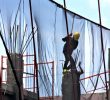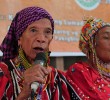.jpg)
American heritage. Bali-inspired. All Filipino. (davaotoday.com photo by Jonald Mahinay)
Lanikai is part of 760 hectares left over to the Tuazon family after the government took over 1,000 hectares as part of the Comprehensive Agrarian Reform Program (CARP). The land itself is rich in history.
In the 1920s, Americans planted the more than 1,700 hectares they owned with abaca for export. In the 1960’s Jose “Boy” Tuazon bought the land and planted it with bananas. Tuazon made the first shipment to Japan in 1969. In the 1970s, Jesus Ayala became Tuazon’s partner. In the 90’s, the partners decided to turn to the tourism and leisure industry because, as Sison relates, it was easier to promote and it required a lot less investment cost. In 1998, the government subjected more than 50 percent of the landholdings to CARP. The Tuazons bought out the Ayalas’ share last year.
.jpg)
Tennis while smelling the salty waters of the sea (davaotoday.com photo by Jonald Mahinay)
Even with the American architecture and history in place, Sison claims that their theme in Lanikai is ‘indigenous’ and closer to a Bali feel.
Sison says the resort’s relaxing ambience has attracted many couples to consider it as a venue for their wedding.
In the future, they also plan to develop the adjacent land. A fishing village is under construction. A clubhouse with a swimming pool, a spa and wellness farm, a lighthouse tower, several restaurants, a driving range and an 18-hole golf course will be up soon.










